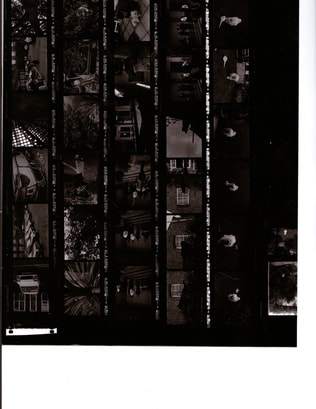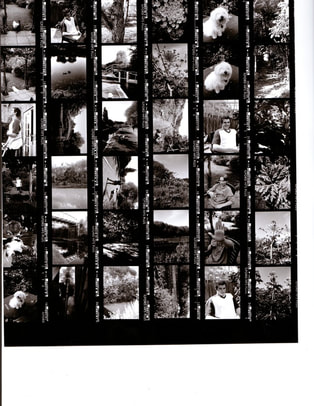MAKING A CONTACT SHEET
This is a positive print of all the frames on the film and made by exposing the whole film in contact with a single sheet of print paper. Each print will be the same size as the negative.
As well as being an easy to file source of reference, a good contact proof shows 'at a glance' which images are not worth printing. Close inspection through magnifying loupe will repeal the quality of the negatives.
A fill 36-exposure roll of 35mm film will fit onto a 10" x 8" sheet.
As well as being an easy to file source of reference, a good contact proof shows 'at a glance' which images are not worth printing. Close inspection through magnifying loupe will repeal the quality of the negatives.
A fill 36-exposure roll of 35mm film will fit onto a 10" x 8" sheet.
- Use it to gain all the information you need to make the best print from each negative.
- Use an old slide mount or a magnifying loupe to view each frame, undistracted by and in isolation of the rest of the frames.
- Mark up the contact proof with wax or chinagraph pencils and circle the best images.
To expose the black and white negatives
- Under the safelight illumination, insert a sheet of printing paper - shiny-side up - onto the enlarger's baseboard.
- Make sure the light is as bright as possible.
- Raise the column to obtain a good spread of light.
- Focus the light.
- Lay the strips of negative on the paper - matt side down.
- Hold the negatives flat so that they come into contact with the paper.
- Place a sheet of clean glass on top of the negatives.
- Stop the lens down three stops.
- Set the enlarger lens to an aperture of f/8.
- Make sure that the enlarger head is high enough for the light from it to cover the sheet of negatives.
- Expose the paper - try an exposure of six seconds.
- Process the print.
|
Acknowledgement:
Tutor: Peter Perry These notes are an accumulation of those written by myself - or obtained from the College during the course.
This is not a commercial site. |
Polly Healy - Course Work : 2000
SOUTH THAMES COLLEGE, LONDON, SW18 2PP ______________________________________________________ Copyright: THE SMOOTH GUIDE TO PHOTOGRAPHY - How to get started ... [email protected] _____________________________________________________ See other Smooth Guide sites: www.animalsandenglish.com www.englishlanguagetips.com www.smoothguide-mahjong.com www.smoothguide-internetfundamentals.com www.smoothguide-kenyacoast.com www.healyshandyhouseholdhints.com www.smoothguide-sunbury.com |



